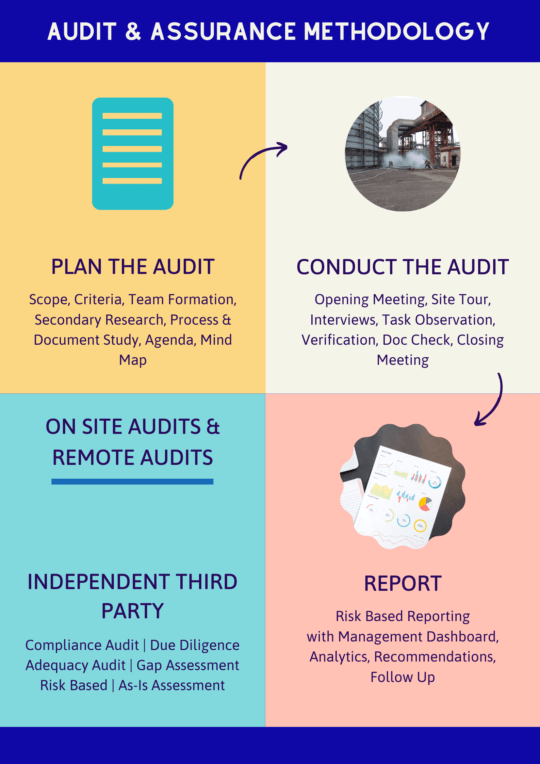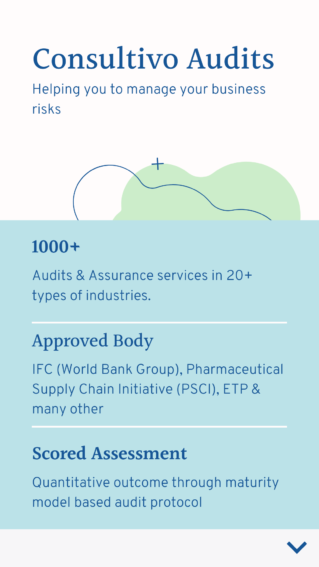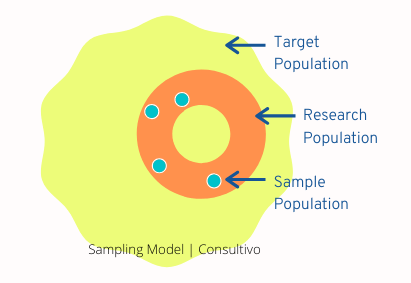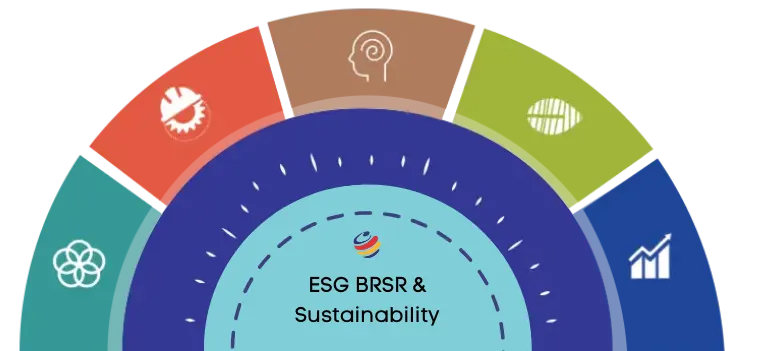Audit & Assurance Methodology
Our robust and time-tested audit methodology ensures risk based deliverables customised to your needs | Risk Focused Protocol Driven method with Quantified Output
IFC (World Bank Group) Approved Independent Consultant







1000+
consulting and audit assignments
Ready to serve anywhere you are
Across the continents
14+ years
at the forefront of Audits and Assurance covering social, environmental, safety, human rights and business ethics issues.
20+ types of Industry Sectors
covering Manufacturing, Mining, Power & Utility, Construction, Service, High rise Buildings and Logistics
Audit & Assurance Methodology
Management audits can be classified into several categories like System Audit, Process Audit, Product Audit, Behavioural Audit, adequacy audit, compliance audit and many more with different focus, purpose and objectives.
How Consultivo Audit Reports are unique?
Consultivo Audit or Assessment or Assurance Reports reflect what the management needs to know – Risks, Controls, Priorities, Compliances and Improvement Opportunities.
We represent them through a management dashboard with charts, heatmaps, analytics & benchmarking.
The outcome is backed up by quantitative assessment at the level of activity, process, system, documentation & people.
Powered by practical knowledge & expertise!
Management of Impartiality, as well as Confidentiality, are imperative in Consultivo. Our values also include that we never compromise on Quality and Integrity, and indeed our Independence has been one of our nonnegotiable assets.

Management Audit Methodology
In Consultivo, we use several national and international standards, code of practice and guidelines to form our own and unique audit method and process. ISO 19011:2018 (Guidelines for auditing management systems) is one of them.
Our assurance, verification and audit method broadly covers the following 3 steps:
Step I: Pre-audit
Defining the objectives, scope and criteria for an audit:
Each audit, assurance, assessment or verification process in Consultivo is based on documented audit objectives, scope and criteria. Physical boundary, processes involved, people involved, organisation structure and audit criteria/standard are predetermined before each audit.
The assessment scope also includes such factors as physical locations, organisational units, activities and functions to be audited, as well as the time period covered by the audit.
The assessment criteria are used as a reference against which conformity is determined and also include applicable policies, procedures, standards, legal requirements, management system requirements, contractual requirements, sector codes of conduct, global good practices or other planned arrangements.
Formation of multidisciplinary audit teams:
Generally management audits are carried out through multidisciplinary audits teams (consisting of 2 to 4 team members) with necessary experience and background to undertake in-depth audit in a particular discipline, industry knowledge and skill set.
One of the team members is nominated as the leader of the audit team.
Preparation of Audit checklists:
Checklists are the most useful tool for standardising the management audit method in a systematic way. A mind map or checklist covering important areas and the audit criteria requirements is prepared before each audit.
Step II: Audit
Opening meeting with the management:
Onsite audit process starts with an opening meeting with the management and the key operational personnel, where the Lead Auditor explains the audit methodology and reporting process.
Audit activities:
- Physical (virtual in case of remote audit) ‘Walk Through’ for basic assessment including task observation
- Document review
- Sample selection & interviewing
- Collecting evidences for both compliance & non-compliance
Closing meeting with management:
Before finalising the report, the audit team initiates a presentation/discussion as feedback to the operating/management personnel of the area/installation.
This provides valuable inputs to the final report based on the discussions and comments received during the presentation.
Step III: Post Audit
Reporting:
Upon completion of the audit process, a detailed report is prepared. The report content generally includes:
- Executive summary including graphical performance indicators
- Overall and segmental rating/scoring (applicable for protocol assessment)
- The scope and objectives of the audit, audit methodology, audit team members, audit dates
- Identification of the reference documents against which the audit was conducted (system standard, auditee’ s manual, etc.)
- Evaluation of “As-Is Status” against established standards (requirements) – good practices, non-conformities and observations
- Audit team’s judgement of the extent of the auditee’s compliance with the applicable standard
- Recommendations for improvement, action plans
- Picture gallery identifying areas of safety improvement

Audit samples and its importance
Sampling is the selection of a set of elements from a target population (product, process, system, activity, person to be interviewed and many more).
Sampling is frequently used and so critical, because collecting data on every member of a target population is often impossible, impractical, or too costly to collect.
A representative sample lets us draw conclusions or make inferences about the population from which the sample is drawn.

How to Determine Representative Sampling Sizes in our audit and assurance projects?
The sampling process in audit or assessment services greatly depends on the sampling skills of the auditor/assessor and onsite realities. Even when the auditor chooses random sampling, there are reasons behind that.
Determinations of sample sizes for specific situations are readily obtained through the selection and application of the appropriate mathematical equation. Inputs needed to determine the minimum sample size are:
- If the data are continuous (variable) or discrete (attribute)
- If the population is finite or infinite
- What confidence level is desired/specified
- The magnitude of the maximum allowable error (due to bias, dispersion, and/or non-reproducibility)
- The likelihood of occurrence of a specific event
How we avoid sampling errors
Our auditors, Assessors and research associates are trained and calibrated to plan and optimise the sampling process to avoid the following sampling errors:
- Bias (lack of accuracy)
- Dispersion (lack of precision)
- Non-reproducibility (lack of consistency)
How do we manage competence and evaluation of auditors and assessors?
Confidence in the audit process and the ability to achieve its objectives depends on the competence of those individuals who are involved in planning and conducting audits, including auditors and audit team leaders.
In Consultivo, competence is evaluated and nurtured regularly through a process that considers personal behaviour and the ability to apply the knowledge and skills gained through education, work experience, auditor training and audit experience.
The evaluation of auditor competence is planned, implemented and documented in accordance with the audit programme, including its procedures to provide an outcome that is objective, consistent, fair and reliable.
Our audit process is based on sound principles
Management System Audit, as well as Assessment & Assurance, are characterised by reliance on a number of principles. These principles help to make the audit method effective and reliable.
We use the following principles of the International Auditing standard ISO 19011: 2018 as a basis of our management audit methods and process.
- Integrity: the foundation of professionalism
- Fair presentation: the obligation to report truthfully and accurately
- Due professional care: the application of diligence and judgment in auditing
- Confidentiality: security of information
- Independence: the basis for the impartiality of the audit and objectivity of the verification conclusions
- Evidence-based approach: the rational method for reaching reliable and reproducible conclusions in a systematic verification process
Adherence to these principles are an integrated part of our audit method and it is a prerequisite for providing audit conclusions that are relevant and sufficient. They also enable auditors/assessors, working independently from one another, to reach aligned conclusions in similar circumstances.
View Consultivo Policies to know more.
Methodology for Remote Audit
Remote auditing through digital interactions:
Fully remote or coupled with physical audits, remote audits can enable time & cost-efficiency, access to competence, increases reach, and mitigate risk.
We ensure the same transparency, diligence, and quality outcome you get in conventional auditing.
Our remote auditing delivery modes:
- Uses ready available communication tools, such as Teams, Meet, Duo (one to one), WhatsApp, etc. on a tablet, smartphone, or laptop.
- Effectively applied in fully remote audits
- Live interactions allow collecting audit evidence
- Enables document sharing and discussions to take place to verify that all requirements had been met
This remote audit shall seamlessly cover the compliance check/review against the applicable statutory and regulatory requirements. Our auditors are trained in remote auditing delivery modes and our procedures are aligned to comply with the requirements.
Audit Method – How does it work?
Remote audit methodologies are very similar to physical audits. The audit centers around the scope and criteria chosen, ensuring that the right audit evidence is collected, verified, and stored according to what the activity requires. However, the interactions and evidence collection process are through digital mode and they are planned or executed a bit differently.
Our audits are Risk Focused
Risk based auditing (RBA) is a methodology that links the assessment process to an organisation’s overall risk management framework. It is primarily focused on the inherent risk involved in the activities or system.
RBA allows verification to provide assurance to the board that risk is being managed by the management effectively, in relation to the defined risk appetite level.

Let's discuss

Curiosity Zone

Some more answers to your questions – FAQ
- It helps in identifying the risk areas with respect to the scope and criteria of the audit.
- Solution-based approach – Solution orientation is a combination of things put together to deliver a higher impact with visible improvements.
- Audit outcome helps in meeting legal requirements as well as it shows improvement opportunities
- Every audit report comes with recommendations from where you may start your next step immediately
- The professional and unique report provides insights
Generally there are 3 types of audit approaches.
- Horizontal Audit – Audit of one system across several functional groups (one issue being verified at many places). Horizontal audit is performed across several groups to evaluate if a consistent approach is being followed with the organisation e.g. for understanding of policy across different functional groups/process owners.
- Vertical Audit – Audit of each function/department of the organization and audit all processes in each function (many things-one place)
- Combination of both
GLOBAL Experience









